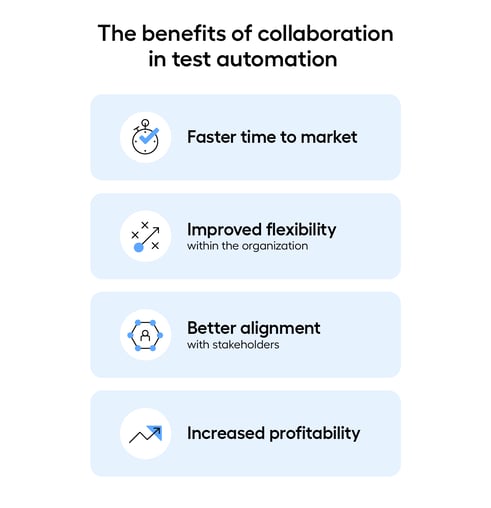Collaboration in Agile Teams: Codeless Automation For All
In order to improve testing processes and transform them into an efficient and cost-effective part of software development, companies are introducing concepts such as agile, DevOps, or BDD in their teams.
The rising adoption of these frameworks is slowly shrinking the gap between IT and business, allowing for more collaboration and continuous delivery. In order to facilitate this collaboration, automation has been brought into play.
However, when we look at software automation, most tools still depend on code. This means that only a selected few can take part in the automation process. Therefore, something that was meant to facilitate collaboration (software automation) suddenly becomes a burden due to complex and code-based automation tools.
Codeless Test Automation
Due to the obstacles that test automation tools present to agile collaboration, codeless automation tools have been brought into the picture. Instead of having humans adapt to machines, codeless tools have forced machines to adapt to us by using our very own language and thought process.
An example is Leapwork, which allows users to design and run automated test cases in a language that everyone understands – visual flowcharts. This visual language hides all unnecessary complexity by using real-world examples that foster a better-shared understanding of how the application behaves. The team’s ability to communicate and collaborate in the software development process accelerates as a result.
Why is Collaboration Important?
Businesses are now operating at a faster pace and, therefore, software development needs to keep up with business demands. In order to guarantee software quality at this development rhythm, the traditional software development process has shifted towards more agile methodologies.
However, agile processes cannot be achieved without collaboration. When people are brought together in a work setting, they can offer various perspectives for problem solving and innovation. Therefore, by bringing different talents together, you create a pool of people with different skills and knowledge that will bring new and alternative solutions to test automation.
And what is the key enabler of collaboration? Communication.
Codeless test automation narrows the communication gap between team members by allowing everyone to create, use and share automated processes. The benefits of codeless collaboration in agile test automation are:
1. Faster Time to Market
Fostering collaboration through codeless test automation enables you to bring products to market faster. Teamwork and communication speed up the entire process by allowing everyone to create and share valuable test automation flows. By breaking down functional silos, the team’s ability to create and deliver value accelerates as a result.
2. Improved Flexibility Within the Organization
Collaboration and teamwork are the foundations of agile, which allows teams to be more flexible and responsive. The more collaboration within an organization, the higher the ability to handle sudden change. This improved flexibility helps the team respond to quick and frequent changes in requirements during the overall development of the application.
3. Better Alignment With Stakeholders
Using a common language that everyone can use allows key stakeholders to be actively involved in the QA process. This means that you’ll be able to leverage their input into your product development process and, therefore, make sure that there’s an optimum alignment between the customer’s needs and the product’s features.
4. Increased Profitability
Empowering everyone to build and understand each other’s test cases will give your team independence and allow them to work in generating innovative ideas that will propel QA forward. No more time wasted in deciphering other person’s test cases.

Codeless tools allow everyone in your team, as well as internal and external stakeholders, to collaborate and work towards the highest standard of QA. They provide all relevant teams with a shared process to collaborate on test automation.
An effective collaborative culture is synonym with accelerated results. Teamwork and communication speed up the entire process and make it easier to produce anything, meaning that you can bring products to market faster. This synergy equals reduced costs, more flexibility in adapting to changes, and increased capabilities.
If you want to learn more about agile testing, download the whitepaper here:

